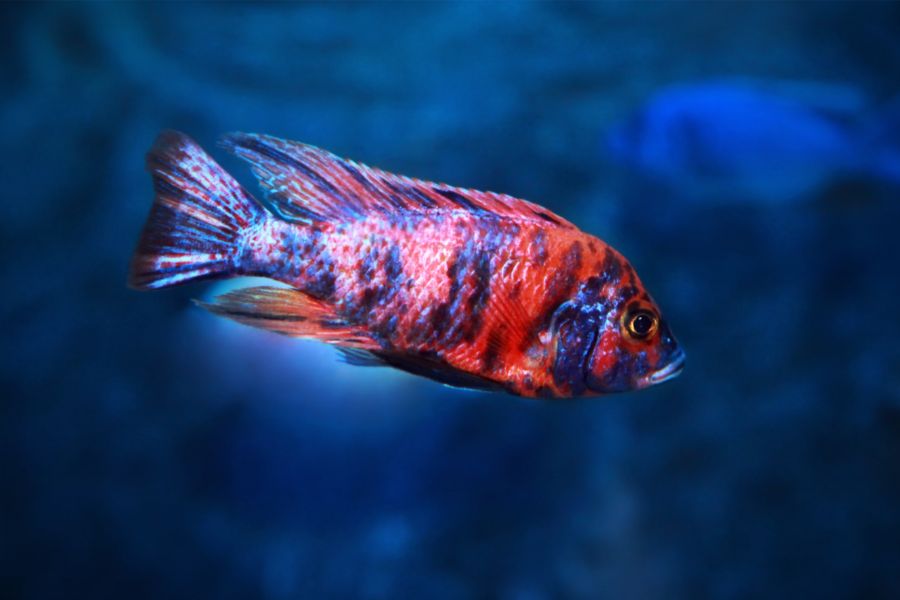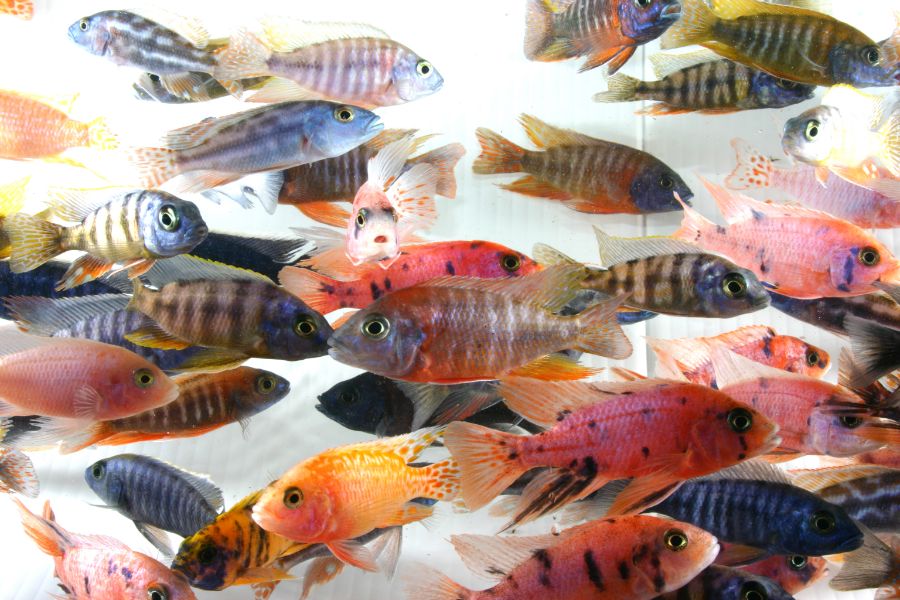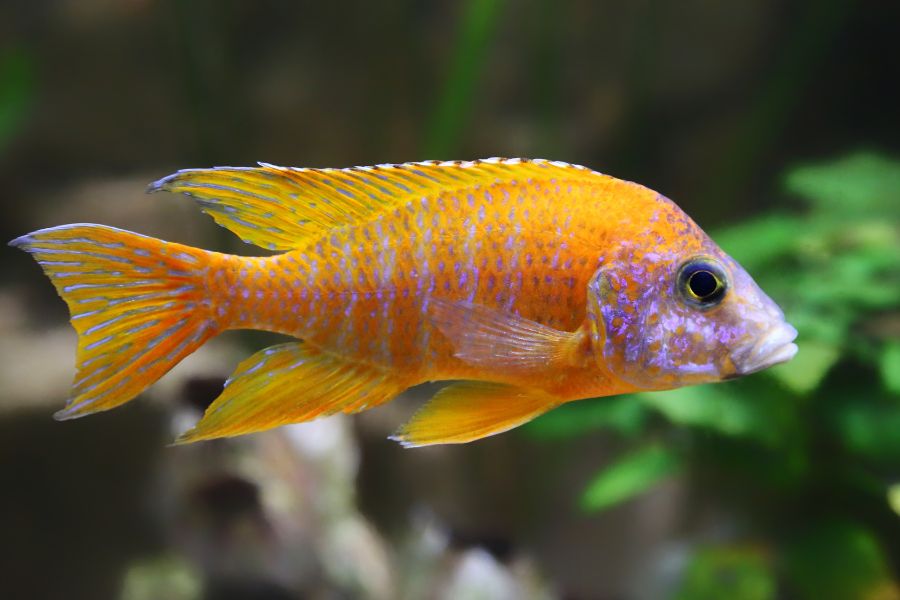Peacock cichlids are among the most attractive freshwater fish, with over 20 different mesmerizing colors.
Some are naturally colored, like the red and blue peacock cichlids, but you won’t look far to find selectively bred colors that match your taste.
Despite being African cichlids, the peacock cichlid is relatively peaceful and will fit into many freshwater tanks and get along with a wide range of tank mates. When caring for this species, the main focus is the tank size and diet.
Read on to learn all the important facts about peacock cichlids. Please get to know their origin and physical attributes.
All you need to know to carefully and successfully care for the gorgeous species is outlined in detail below.
Peacock Cichlid Overview
Short Summary on Peacock Cichlids and their habitats:
| Names | Peacock cichlids
Popularly known as peacocks or aulonocaras |
| Scientific Name | Aulonocara sp. |
| Origins and Reginal Distribution | Originated from Lake Malawi in East Africa |
| Tank Size | 100 gallons minimum for a community (4 – 6 peacocks)
150 gallons minimum for more adults and breeding purposes |
| Water Hardness Conditions | 4 – 6 dGH |
| Ideal Tank Mates | Less aggressive, equal sized fish. |
| Average Size | 3-4 inches, almost 6 inches in the ideal environment |
| Colors | Comes in a wide range of colors. Red and blue are most common |
| Breeding | Mouthbrooding |
| Lifespan | Typically, 6 years, but can live up to 8 – 10 years in the ideal environment |
| Lighting Conditions | Low light for up to 12 hours |
| Diet | Omnivorous |
| Optimal pH levels | 7.5 – 8.7 |
| Optimal Temperature | 75 – 85 degrees Fahrenheit |
Commonly known as peacocks, the species originated from the shores and shallow waters of the tropical Lake Malawi in East Africa.
It is predominantly distributed across sandy substrate with lots of rocks in Lake Malawi, surrounded by many other types of African cichlids like the red dwarf cichlid, convict, jewel, and electric yellow cichlid.
Lifespan
The average lifespan of the peacock cichlid is six years, but you can find some peacocks that live for more than 8 to 10 years in the most ideal/natural environment.
The lifespan varies depending on how well you take care of the fish. Stable water parameters ranging between acceptable limits will go a long way in extending the fish’s life.
Appearance: Types, Colors & Size
Peacock cichlids feature streamlined fins pinned on sleek, long bodies. Their torpedo shapes make them easily identifiable, but their colors are so many that it can sometimes get confusing.
Over 20 color variants exist, but red and blue are the most common. Other common peacock cichlid colors include the albino, yellow, red, orange, blue, pink, and purple.
Popular types of peacock cichlids include:
- OB peacock cichlid – red base color with dark blue spots that are spread throughout the body but more prominent on the fish’s head.
- Dragon blood peacock cichlid – red base color that is distinguished from other types with its dotted spots and blotches throughout its body.
- Strawberry peacock cichlid – red base that can sometimes come out as pink. The entire body is complimented with strawberry colored spots and patches.
- Sunshine peacock cichlid – dazzling yellow base color with light blues spread throughout the body. The blues are more intense on the mouth and bases.
- Blue peacock cichlids – prominently blue without any patches but some orange spots and dots may be seen in some.
- Red peacock cichlid – most aquarists stock these red peacocks with red base colors throughout the body complimented with white patches.
- Albino peacock cichlids – are rarer than the red and blue cichlids. Feature whitish bodies or faded color bases complimented by intense red eyes.
When it comes to differentiating between the sexes, female peacock cichlids are an inch shorter than their male counterparts. They also feature thicker and rounder body shapes than males.
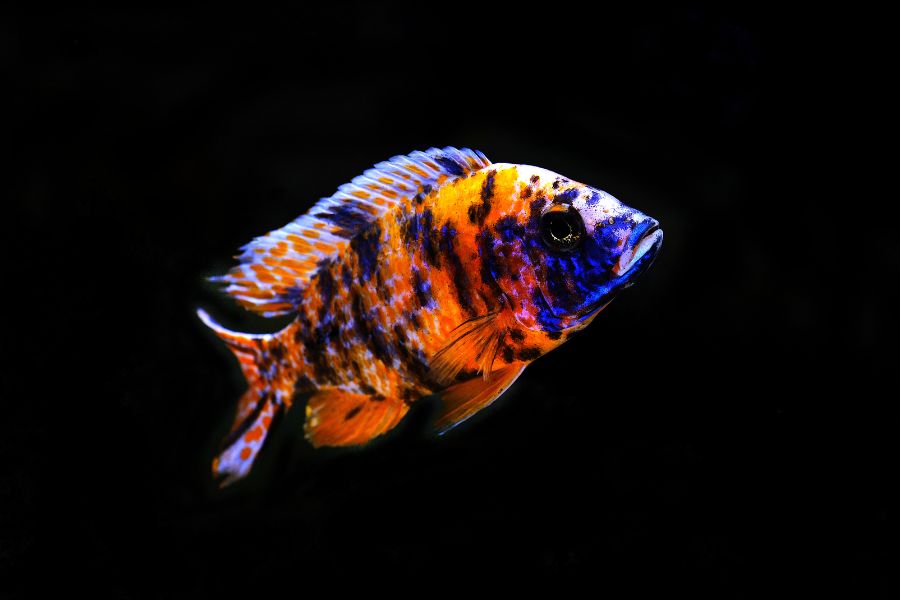
Male peacocks, on the other hand, have brighter and more intense colors than females. These colors start becoming brighter than those of females during the maturity stage right before the breeding stage.
Bright male colors are a vital part of the cichlid since it helps in the mating season by attracting the paler-colored females.
Some aquarists have noted that stressful conditions can affect the peacock cichlid’s colors by making them less bright. You can use duller color changes in your fish to see whether your water and tank conditions are befitting your peacocks.
In many cases, this translates to higher prices when you search for peacocks for sale online or on the local store market.
Behavior
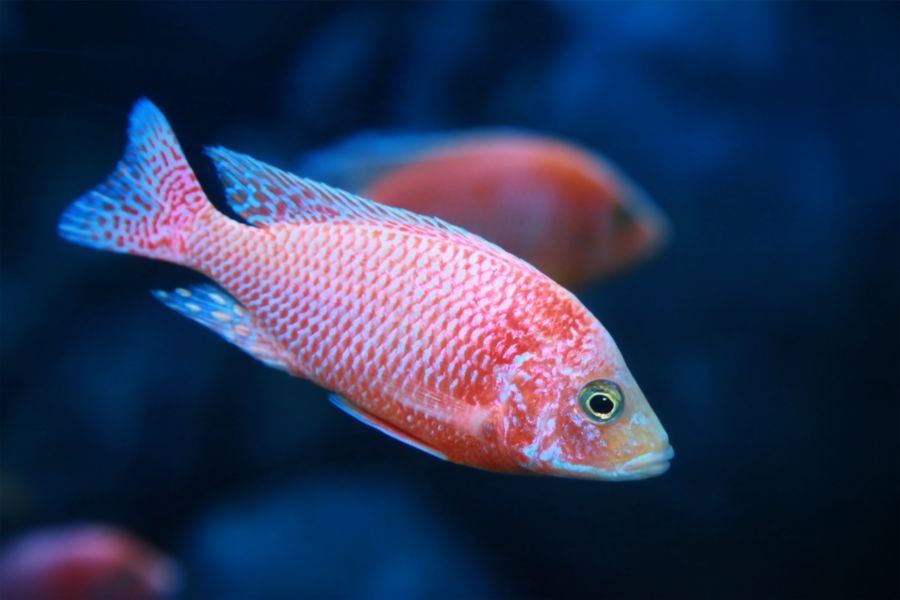
Peacocks are friendly and semi-aggressive. They get more territorial in crowded environments or when they get stressed. These African cichlids will get more aggressive in tight spaces and overpopulated tanks.
But you can expect your peacock cichlids to be peaceful most of the time.
The male-to-female ratio of the species also increases mating competition, making them more aggressive and territorial. You will notice frequent fights and chases if the cichlids are cramped in the tank.
Peacocks are active, skilled swimmers who are always up and about in the tank. They are not nocturnal, which means you will not find them swimming or feeding at night. Nighttime is when they rest, particularly at the bottom of the tank.
Peacock Cichlid Care Guide: Tank Size, Aquarium Environment, Diet, Breeding
Like other African cichlids, peacocks are a hardy species that can withstand many tank conditions and water parameters. However, it is always best to stick with stable conditions and encourage ideal setups.
Tank Size and Environment
As active and skilled swimmers, you should have a huge tank that gives them enough space to swim from the bottom to the mid-depths of the tank.
With this in mind, you should prioritize putting the peacock cichlids in a tank that is longer horizontally than it is vertically. More horizontal space is great for their active shallow water lifestyle, while more vertical space may stress them with its deep depths.
An ideal tank size is 100 gallons minimum for a small community of about five cichlids (one male with up to four females). You can also choose to raise a single peacock cichlid in a 50-gallon tank.
Tank mates are not an issue with the peacock since it is a sociable creature, compatible with many freshwater fish.
However, please do not put them with more aggressive fish and larger fish that can feed on them or bully them. It is best if you avoid pairing the peacocks with bettas, Oscars, and tiger barbs.
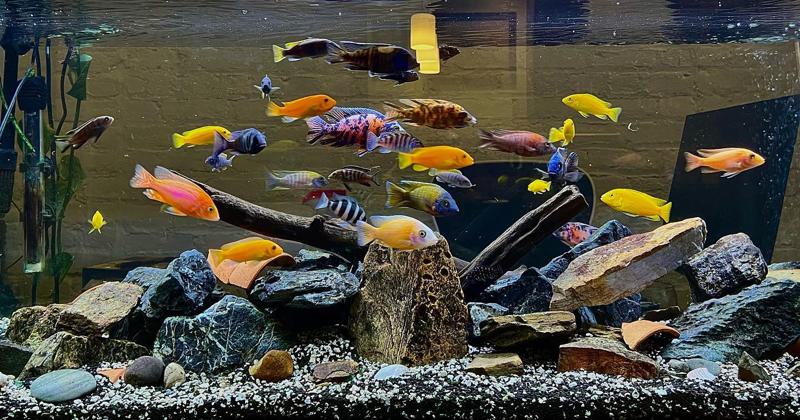
Some of the best tank mates for the polar blue parrot cichlids include:
- Other peacock cichlids
- Azureus cichlid
- Star sapphire cichlid
- Botia loaches
- Red tail shark
- Electric blue cichlid
- African red eye tetra
- Synodontis catfish
- Cuckoo catfish
- Parrot cichlids
- Rainbow shark
- Clown Plecos
- Mbuna cichlids
Peacocks aren’t typically violent, but you should use strongly rooted plants that the aggressive movements of the fishes can’t easily uproot. Caves, hollow décor, and rocks also go a long way in simulating their natural habitat.
Include sandy substrates with fewer rocky or hard substrates. Peacock cichlids are active eaters that love to ravage for food in the sandy substrates. Rocks and hard décor may lead to physical trauma but are good as hiding spots and egg-laying surfaces.
Also Read: African Cichlid Tank Size & Setup Guide
Water Quality & Water Parameters
Poor water quality is the leading cause of death in peacock cichlids, and this can be easily prevented in by keeping these conditions stable:
- Water Temperature: 75 – 85 degrees Fahrenheit
- pH level: 5 – 8.7
- Water hardness: 4 – 6 dGH
- Ammonia, nitrite levels: 0 PPM
Peacock Cichlid Diet
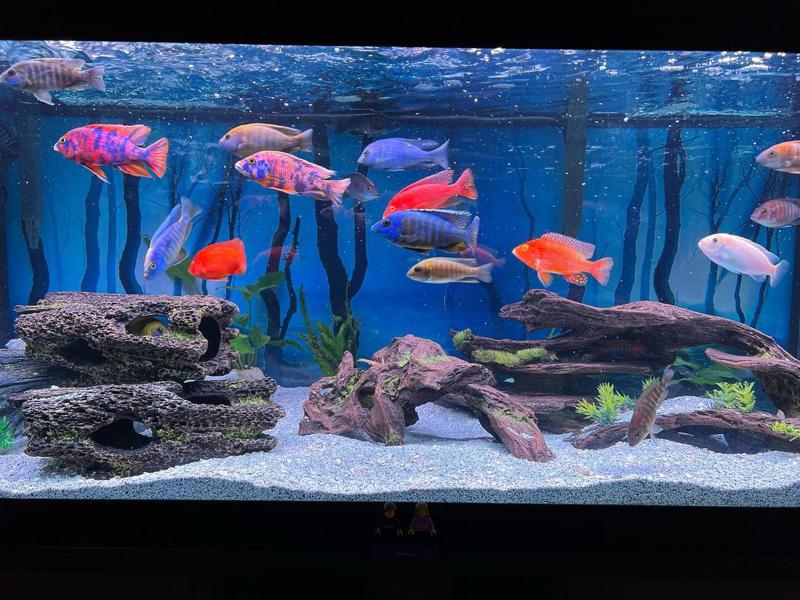
Peacocks are omnivores that feed on anything they can digest.
They are also active eaters that feed on algae, making them a good option if you are looking for tank-cleaning crews. They also feed on the zooplanktons, crustaceans, and larvae located all over the aquarium.
Malawi bloat is one of the most common diseases that will affect your cichlid. The disease is largely caused by overfeeding your fish (especially on a meat-heavy diet), and you will see this when they start to develop bloated bellows, lose appetite and have problems with breathing.
You can avoid the Malawi bloat, as well as excessive biowaste production, by feeding the fish two to three times per day in just a few minutes.
Provide the peacocks with tiny bites of their meals and wait for about five to eight minutes till all the food is gone. If some are left after a few minutes, then you can tell they are full, and the leftovers will only affect their diet. Scoop the uneaten food to prevent water contamination and excessive waste.
Some of the best foods for peacock cichlids include:
- Brine shrimp
- Hikari pallets
- Frozen bloodworms
- Frozen krill
- Crickets
- Algae wafers
- Earthworms
- Vegetables like peas, spinach, cucumber, broccoli, lettuce, and zucchini
- Cichlid flakes
Breeding
Peacock cichlids are mouthbrooding fish that start breeding after nine months after their birth.
They get more territorial and aggressive during this period, so it is important to keep up to four female peacocks with one male. This will help smoothen the mating process.
Another precaution to take is to ensure you separate the babies from the parents. Protective maternal parents tend to eat their young ones, although this is not a naturally commonplace incident.
The female is the one who lays eggs and takes them into her mouth for fertilization and mouthbrooding. The birth rate for the peacocks is about 12 to 15 fry hatches in one breeding season.
Follow these three simple steps to successful breed you peacock cichlids:
Step 1: Separate the Breeding Pairs Into a Different Tank
You will need a bigger tank for breeding, about 100 gallons minimum for up to two pairs of breeding cichlids. Proceed to ensure the temperature, pH, and diet is optimal for the breeding species.
Best parameters for peacock cichlids to breed include:
- Temperature: above 82 degrees Fahrenheit
- Diet: High Vegetable Diet, fewer proteins/meats diet (fry brine shrimp and infusoria are good choices)
- Water pH levels: Above 7.8
Also ensure that the is sandy substrate at the bottom with enough cave décor that provides a conducive environment for breeding.
Once you place the fish into the breeding tank, the male will mark his territory in the cave décor and will attract a female peacock by showing off his colors in a ‘mating dance’ ritual. One of the female peacocks will be attracted, and the mating will begin.
Step 2: Breeding Starts in The Tank
The pair then mate in the marked territory, after which the female peacock lays its eggs in the nest. She then proceeds to take the eggs into her mouth immediately. The male will then fertilize the eggs in the female’s mouth, starting the pregnancy period.
Feel free to take out the other remaining females in the tank to give the pregnant female time to give birth.
Female peacock cichlids carry their eggs in their mouth for about 10 to 15 days before the eggs hatch. The mother will continue to carry the hatched fry in her mouth for an extra two to three weeks, occasionally letting the babies out to feed.
This is when the male should be taken out of the tank. Females are very protective of the babies and will often take the babies in and out of their mouths to prevent them from harm. On the other hand, the males can feed on their babies, making them a bad pair in the tank.
Step 3: Put the Babies in The Main Tank
Young juvenile peacock cichlids are fit to freely swim and fend for themselves when they reach about 2 inches long. This will happen in less than 3 months. Feel free to take the 2-inch babies and add them to the main tank.
Also Read:
Summing Up
Peacocks are susceptible to many diseases that can affect other fish as well. Common peacock illnesses include Malawi bloat (the most serious), caused by poor nutrition, and swim bladder diseases caused by swim bladder parasite infections.
Both of these diseases can be prevented by first ensuring you feed your fish the right diet as recommended above or by your pet shop.
Also, ensure you perform regular water maintenance and use recommended treatment from your veterinarian.
